
28 minute read
b.1.1 Design opportunties b.1.2 Design principles
A03b.1.1 - Design Opportunties & Principles - Design Opportunties
Design Opportunties
Advertisement
We classify the existing risks and propose four design directions which is the design for space, system, installation and activity, as potential design possibilities of the site.
A03b.1.2 - Design Opportunties & Principles - Design Principles
Design Principles We put forward 16 design principles to address the 16 existing risks that the Flinders street is facing, and at the same time, these principles are put forward to serve certain site users. Design Principles Clients Design Principles
Risks For Women Social Risks
Traffic Risks Natural Risks

A03 - Design principles and testing - Flinders Street
A03c.1 Design Principles
Priorities In this chapter, we will carry out detailed analysis and testing of the generated design principles for site. From our reserach and site analysis, we have identified 4 keys issues to be addressed through our design principles; Safety of Women & Minorities, Traffic, Environment and Social. In developing principles around these issues, we aim to improve the overall quality of site.

At the same time, our design principles have three main goals. A. Improve the site and experience of the site for women and minorities. B. Encourage residents to use outdoor space with equal right. C. Reflect the future urban development of Melbourne.

A03c.3 - Design Principles - Safety Street for Traffic
Safety Street for Traffic This part is divided into before and after of the new policy. This diagram shows 4 objects, 4 principles and 6 strategys in this part.The most important consideration is the safety of pedestrians and cyclists, after analyzing their major activities and requirements, design tests are performed.
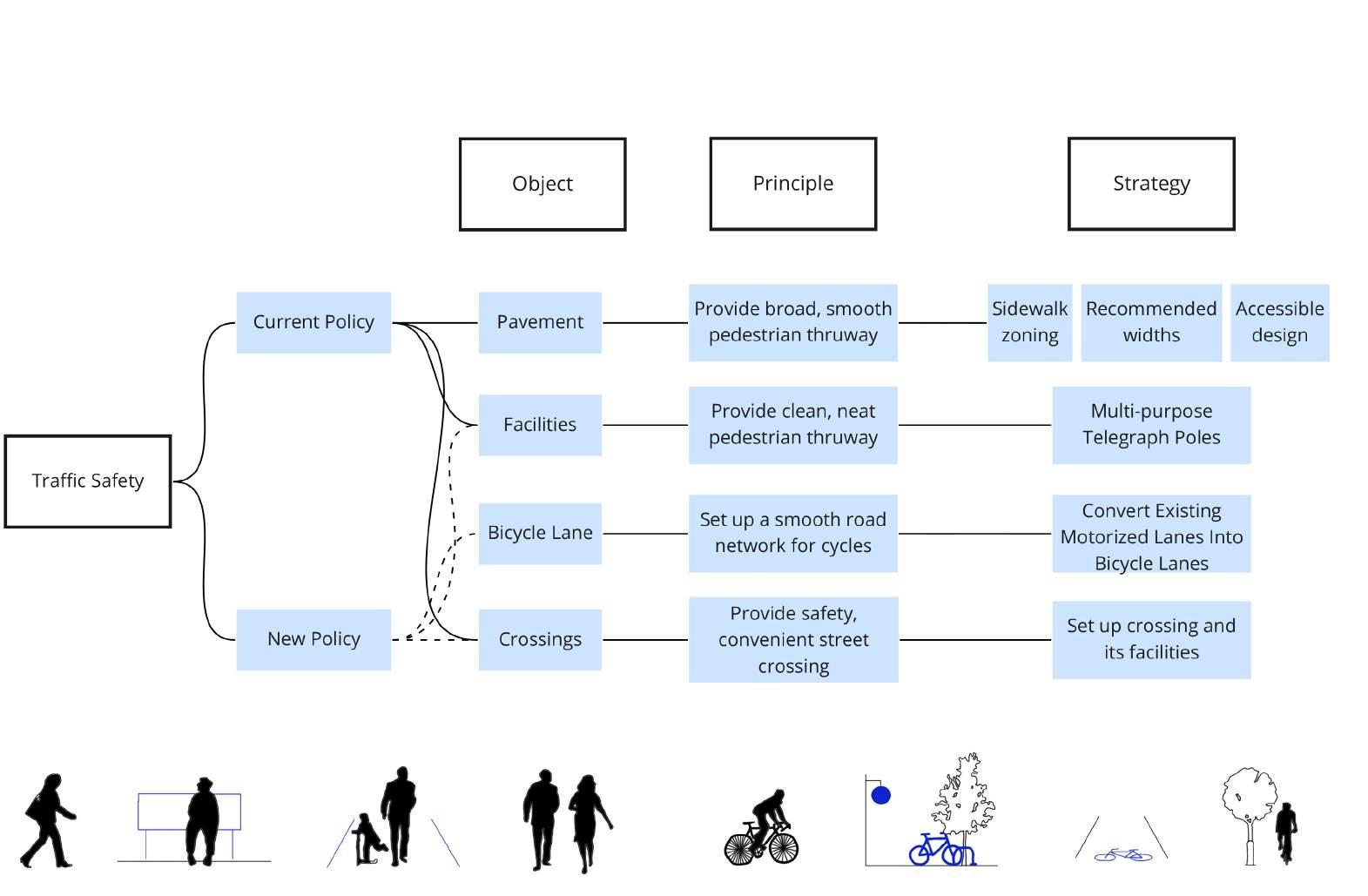
A03c.4 - Design Principles - Street Safety For Local Community (Society)
Street Safety For Local Community (Society) As a part of a street, community residents shall enjoy equal sovereignty over the use of the street.The design principles specified in response to the existing risks on Flinders St, it could help residents have a safer outdoor space. The design of principles are based on the 'urban public space design guideline' from Melbourne city council.
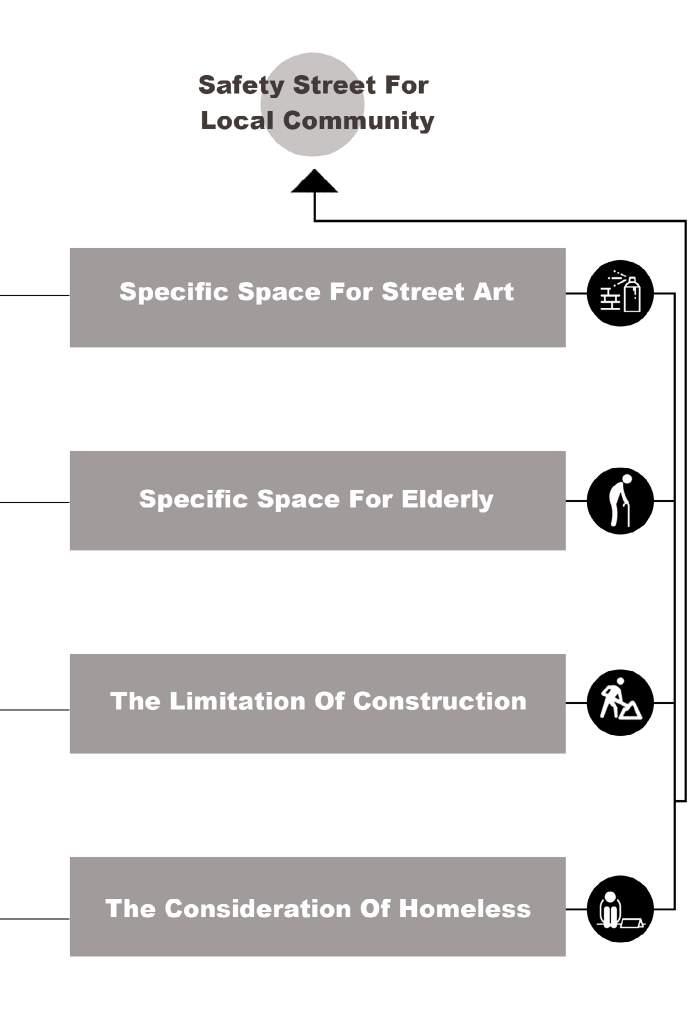
The Control Of Street Art
· Remove unwanted graffiti applied without permission · Street art placed on walls and infrastructure with the permission of property owners.
This is based on the Urban Space Design Guideline about 'Street Art' from Melbourne city council. All the graffiti and street art should under control.
The Space For Elders
· Make sure there are areas suitable for elderly people to rest on long distance roads. · Add handrails to help the elders' walking. · Reduces injuries to the elderly due to collisions caused by the flow of people.
The Control Of Construction
· Barriers and signs to prevent pedestrians from entering the construction area. · Site shed, reduce the impact on the environment. · Noise abatement to reduces the impact of noise on pedestrians.
Take Care Of Homeless
· Set up homeless center, provide living service, including food, toilet, bed. · Remove the homeless people who are affecting road safety to homeless center.
Reference Code of practice: Building and construction. (n.d.). Retrieved April 30, 2021, from https://www.melbourne.vic. gov.au/building-and-development/planning-and-buildingservices/construction-development/legislation-guidelines Street art. (n.d.). Retrieved April 30, 2021, from https:// www.melbourne.vic.gov.au/arts-and-culture/art-outdoors/ Pages/street-art.aspx
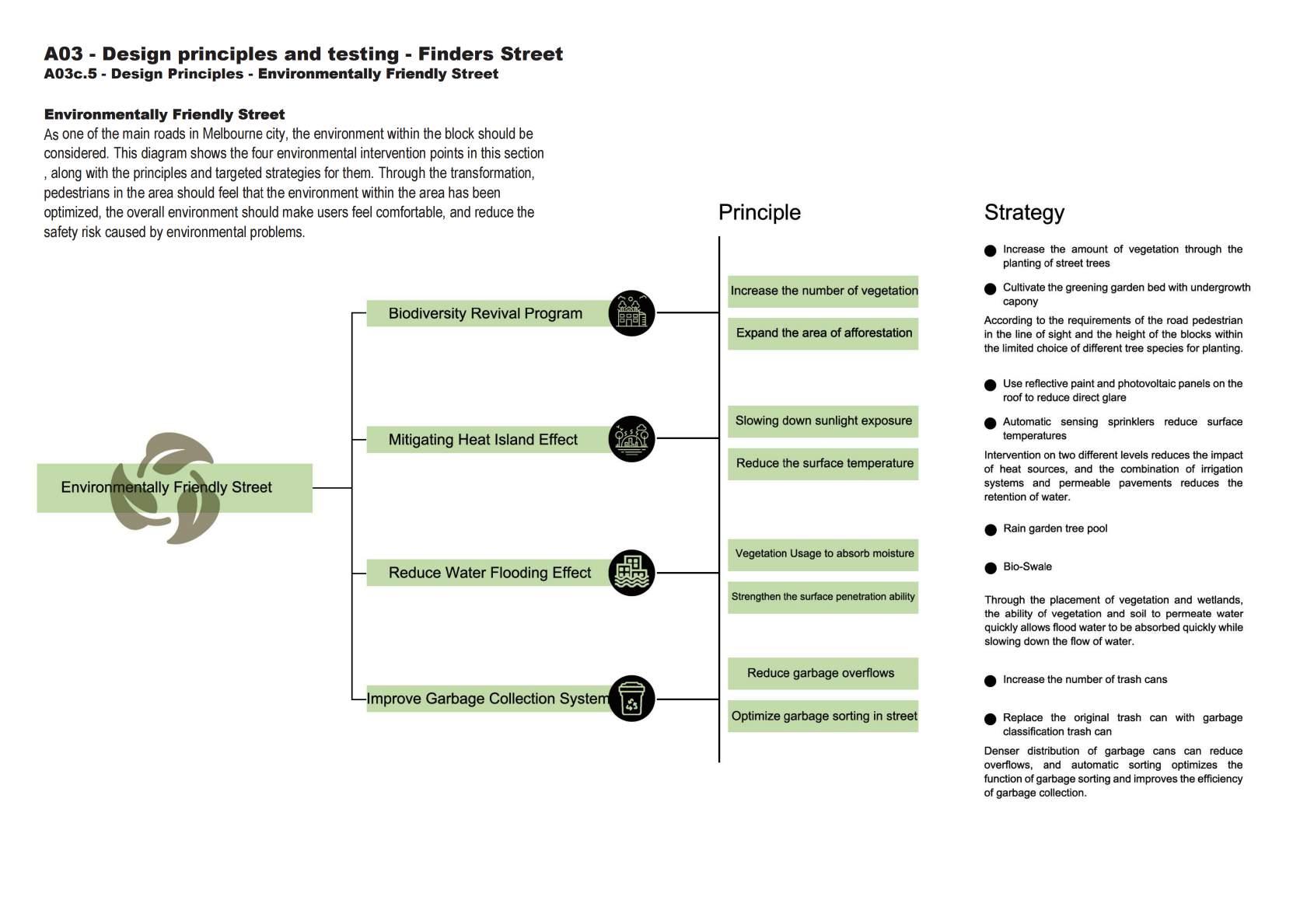
A03 - Design principles and testing - Flinders Street
A03d.1 Design Testing
In this chapter we begin to test the proposed design principles, to explore the feasibility and effect through spatial intervention and design interation.This is an interactive process, where design principles guide design tests, and design tests give feedback to design principles. We test designs for our 4 key issues; Safety of Women & Minorities, Traffic, Environment and Social.
A03d1.1 - Design Testing - Safety For Women & Minorities - Crowds
Site Condition

A03d1.2 - Design Testing - Safety For Women & Minorities - Lighting
Site and analysis and community consultation has revealed lighting to be a major risk factor on site. The existing lighting in most of the space comes from average street lights and general light pollution from the urban context. Some of the existing street lights are dim, faulty or not in use. To address the lighting issue in the space we have drawn from research by Plan International, the Monash University XYX Lab and ARUP lighting researchers in 2019 -
‘The analysis showed that consistent and layered lighting – where there are multiple light sources and where surfaces with different reflective values are taken into consideration – makes women feel most safe. This kind of lighting reduces the “floodlit effect”, the sharp drop-off of light beyond the path, and the potential for glare and contrast to blind and disorientate. The emphasis on LED lights for their energy efficiency is unquestioned. But in urban lighting they are mostly a higher colour temperature such as 4000K “cool white” and above. This new research challenges the effects of this approach. ARUP’s research shows the human visual spectrum reacts better to warm light, and the data from young women showed how sensitive they are to cool white light with regard to feeling safe in cities. Spaces with warmer colour temperatures are perceived as safer places.’
Site opportunities for improved lighting
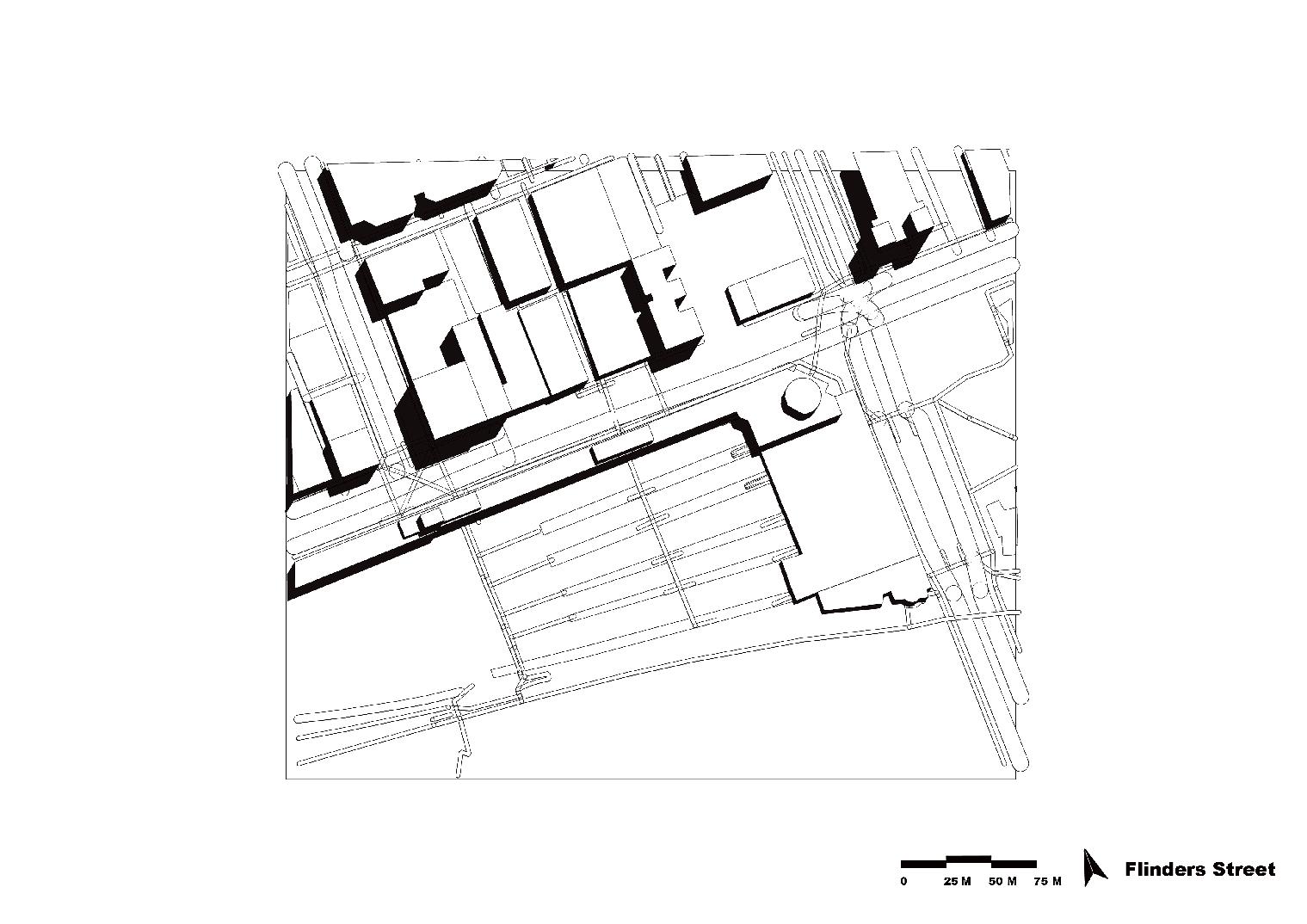

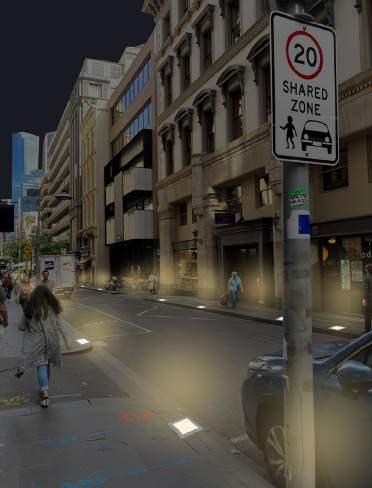
Existing lighting on Flinders Lane Layer 1 of lighting intervention: Ground LED lights create a warm, soft light lessoning the floodlit effect and providing greater visibility

Layer 2 of lighting intervention: Modeling DeGraves St, fairy-lights provide a canopy of light and contribute to the welcoming and friendly quality of the space

Integration - existing and new lighting: The laying effect of the 3 level of lighting provides overall visibility, warmth and enhances the safety of the street
A03d1.3 - Design Testing - Safety For Women & Minorities - Alleyways, Disused Streets & Flexible Programming
These design principles intend to improve the safety and overall quality of the most significant risk factor identified in this site, the many alleyways and disued spaces. This is achieved through changing the programming of these spaces from dark, neglected back-ways to invigorated social and cultural gathering spaces. In conjunction with the lighting intervention, simple changes to the use of space intends to bring life to these areas, provide spaces for economic, social and cultural gain and improve the safety of this site overall. The programming is intentionally flexible - adopting a ‘pop-up’ quality in order to allow for these spaces to continue to be used for other practical means at other times.


Sites for flexible programming opportunities
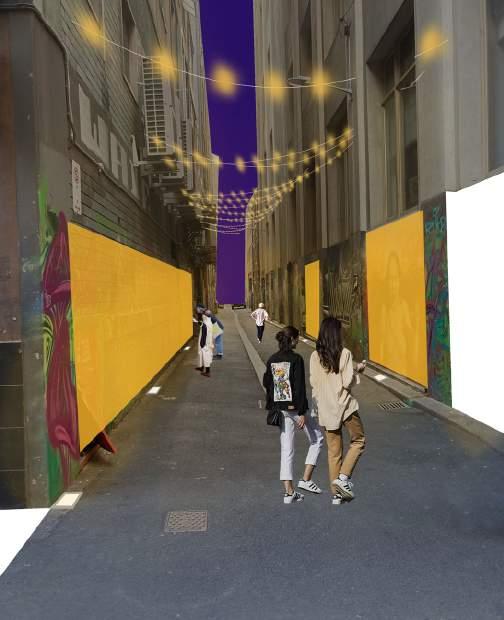
Lighting intervention and ‘art-way’ intervention This principle employs art from local artrists as a ‘placemaker’, giving quality and purpose to the space and thus improving the safety of site.
Lighting intervention and flexible dining space - Flinders st Local hospitality businesses are given license to spread their seating into the streets at certain times of day i.e. after dark. New businesses are encouraged to occupy empty shop fronts on Flinders st. Pop-up vans and events can make use of this seating too, providing these spaces with flexible programming which brings in crowds, enhances the cultural and social qualities of the spaces and thus improving the safety.
A03d1.4 - Design Testing - Safety For Women & Minorities - Visual Guide

A03d1.5 - Design Testing - Safety For Women & Minorities - Underground Passage

A03d2.1 - Design Testing - Safety Street for Traffic - Walking Space for Pedestrian
Objective: Walking Space For Pedestrian
Principle: Provide broad, Smooth Pedestrian Thruway
From the site analysis, it can be seen that the street has a large flow of people, and the ground floor of the buildings along the Finders Street. is mostly for commercial and office functions.
For walking space, it is relatively crowded, and the form of a single, no greening and other problems.


Strategy1: Sidewalk Zoning
Sidewalks should be zoned into pedestrian thruway, facility belts and frontage of buildings to create a required space where Walking through zone, facility set-up and buildings are closely connected.
Pedestrian thruway: Effective passage space for pedestrians. Facility belts: Sidewalk along the road greening, rest and other facilities of the belt space. Front area of buildings: The residence and activity space adjacent to the building fronting the street.
Only for pedestrian Pedestrian thruway + front area of buildings
Facility belts + pedestrian thruway Facility belts + pedestrian thruway + front area of buildings
A03d2.2 - Design Testing - Safety Street for Traffic - Walking Space for Pedestrian
Strategy 2: Recommended Widths of Pedestrian Thruway
The width of pedestrian thruway should meet requirements of pedestrians. An appropriate width should be determined by taking into consideration elements like road grade, development intensity, extene of function mixture, commercial activities and public transport services.
1.5 m
Adjacent to wall 3 m
Adjacent to inactive wall 4 m
Adjacent to active boundary or along main transit corridor
5 m

Major business street and within the rim of entrances to transit stops 4 m
Strategy 3: Accessible Design
Pedestrian access areas should be consistent and smooth, avoid unnecessary elevation differences, if there is a difference, should be set up slopes and other barrier-free facilities.
There must be safe and continuous blind roads in the walking area to ensure that the blind can travel without obstacles.
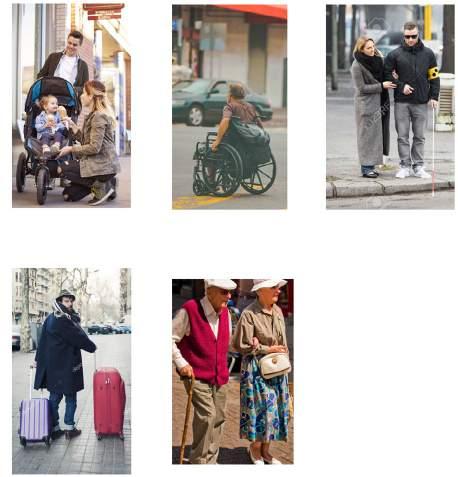
The group of people that must be considered when designing pedestrian streets:
1. Parents with stollers 2. People in wheelchairs 3. Tourists with suitcases 4. Seniors with limited mobility 5. The visually impaired
A03d2.3 - Design Testing - Safety Street for Traffic - Walking Space for Pedestrian
Strategy 4: Multi-purpose Telegraph Poles
According to the analysis of the site, it can be seen that there are a lot of facilities scattered on the pavement and there is no place for the vulnerable people mentioned in the previous strategy to rest. The fourth strategy set up public facilities and street furniture along a street in an intensive way to make the street clean and orderly.
Test Zoom in
Section A - A`

According to the strategy, There is a need to integrate the scattered facilities on the sidewalk. The existing facilities of the street were integrated, such as street lights, traffic lights and signs, etc., while pedestrian seats and solar panels were added to help vulnerable groups and reduce electricity consumption.
Schematic diagram of existing facilities integration
A03d2.4 - Design Testing - Safety Street for Traffic - Continuous Bicycle Lane
Objective: Continuous Bicycle Lane
Principle: Guarantee A Smooth Road Network For Cycles
Strategy: Convert Existing Motorized Lanes Into Bicycle Lanes
According to the site analysis, the current street has no cycling path. Under the premise that the street is no longer accessible to motor vehicles, in order to provide continuous and safe bicycle path for cyclists, the original motorized road is changed into a bicycle path.
Test Section
New Policy Research: Melbourne CBD could be free of cars ‘by 2030’
Design Testing Under The New Policy
Test Zoom in
To better explain the test section, select a hot spot area and zoom in.
In the context of the new policy, first of all, keep the existing tram road unchanged, second step, turn the motor lane into the bicycle lane, third step, widen the pedestrian area. In order to ensure the safety of trams, cyclists and pedestrians, plant barriers or height differences are set up at each area junction.
Test Zoom In Masterplan

A03d2.5 - Design Testing - Safety Street for Traffic - Pedestrian-Friendly Crossings
Objective: Pedestrian-Friendly Crossings
Principle: Provide direct, Convenient Street Crossing Options To Ensure Pedestrians Through Intersections Comfortably
Strategy: Set Up Crossing And Its Facilities
Street crossing facilities are designed at an appropriate distance for pedestrians to cross streets without having to go far. Longer streets and crowded sections should be equipped with intermediate crossing facilities, such as large public service facilities and apartment entrances. Generally, the spacing of crossing facilities should be controlled within 100 meters, and the maximum is not more than 150 meters. Select a T intersection on the street that is currently without any crossing facilities


Test Zoom in
Crossing Tests
Testing the existing striping type on the street in first picture, then two different stripings were tried, finally add high-visibility, flashing pedestrian crossing signs. Obvious striping and sign are importent even though there are no cars here anymore. This will remind people not to jaywalk and remind cyclists to slow down.
A03d3.1 - Design Testing - Street Safety For Local Community (Society) - Specific Space For Street Art
Specific Space For Street Art
The current graffiti on Flinders St may contribute to feelings of an unsafe atmosphere, appearing unkept and dishevelled. To address this we have developed the following approach: 1. Clean up and control, clean up existing illegal graffiti and control the site by street art policy. 2. Guidance, encourage the street artists create pieces in the spaces provided and allotted.
Intention Image


A03d3.2 - Design Testing - Street Safety For Local Community (Society) - Help The Homeless
Information Transmission By Posters
Posters can be used for both information communication and information collection.
1. From posters, homeless people can get helpful information about nearby NPO and resources available to them. 2. From posters, the local government can gather the voices of the people, and receive donations from pedestrians.

Pedestrians can donate to local NPOs by scanning a QR code.
Homeless people can get information about welfare resources around them.
A03d3.3 - Design Testing - Street Safety For Local Community (Society) - Protect Pedestrian From Construction Site
Reduce The Imapcts From Construction Site
The construction site is restricted to reduce its negative impact on pedestrians and surrounding space.
1. Forewarning signs are placed on the road before people enter to the construction site to remind people to observe the space and protect themselves.
2. Isolation cover is used to separate the construction site with surrounding space to reduce the impact to people, Eg. noise.

A03d3.4 - Design Testing - Street Safety For Local Community (Society) - Protect The Cultural Diversity
Protect The Cultural Diversity
Cultural diversity is one of the proud characteristics of Australia, and yet racism and division is an ever-present issue. How can the design of urban space help to mitigate this? 1. Protection, temporary roadblocks are used to restrict traffic and people on Flinders St, to protect the parades descending Swanston St, and to hold space for cultural celebration. 2. Encouragement, encourage people to use the open public space near flinders station as a cultural festival celebration plaza.
Pictures From : 2014 Australia day STREET PARADE fireworks display in Mornington. (n.d.). Retrieved May 11, 2021, from https://www.weekendnotes.com/australia-day-street-parade-fireworks-display-mornington/

A03d3.5 - Design Testing - Street Safety For Local Community (Society) - Rest Area For Elder & Disable
Street Rest Space
The long & crowded streets may be difficult and unpleasant for elderly and alternatively abled folk to use. Rest spots make the space safer and more accessable for all. 1. Street bench, add benches on Flinders St, the bench design should based of the guideline Australian Disability Discrimination Act 1992. A rest area is set up every 60M. 2. Vegetation, add street trees as natural sunshade for people to use. This also provides more natural elements to the urban space, improving the atmosphere.
How to Apply DDA to STREET Furniture: Seats and tables. (2019, September 24). Retrieved May 14, 2021, from https://streetfurniture.com/how-to-apply-dda-to-street-furniture-seats-and-tables/


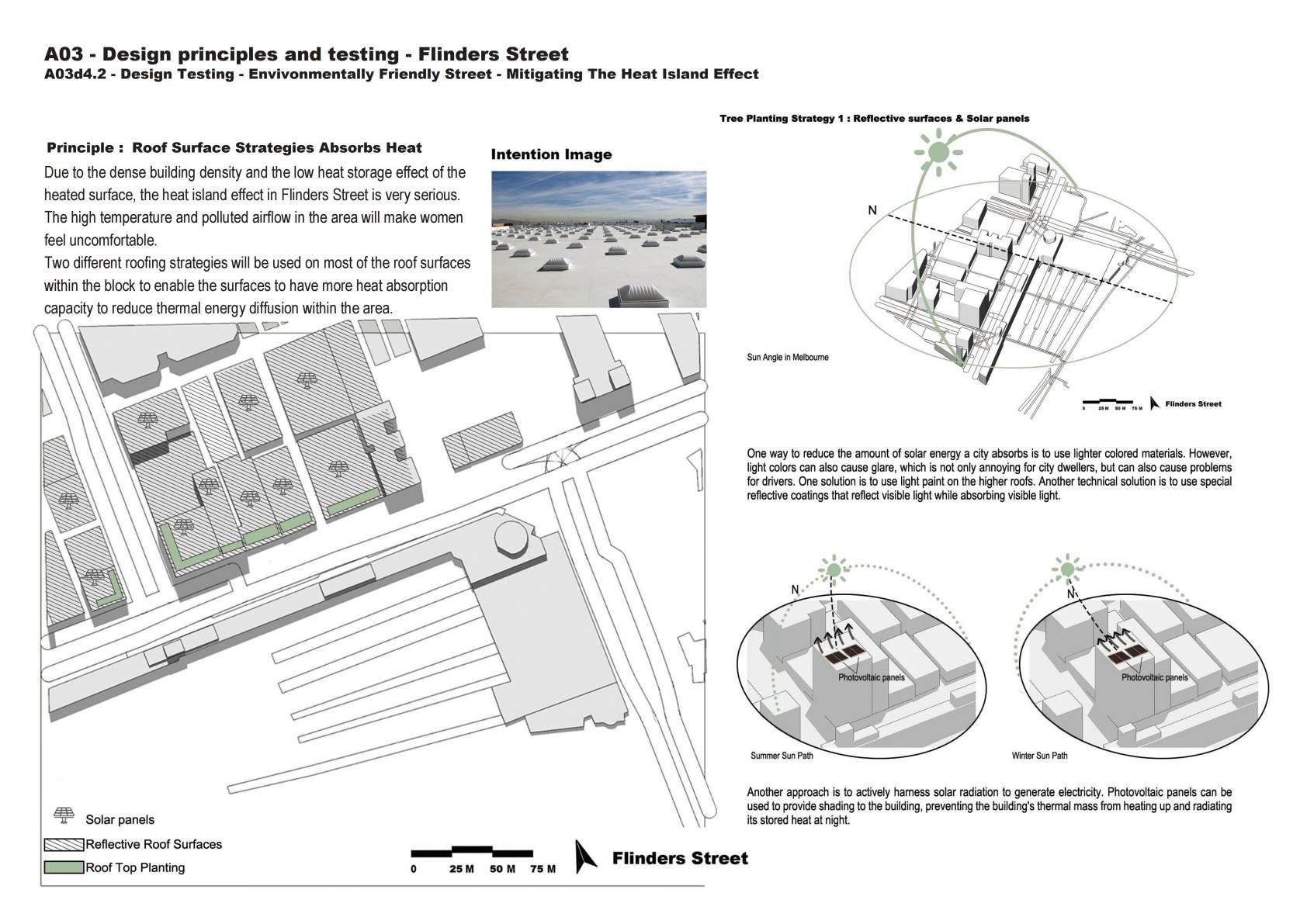
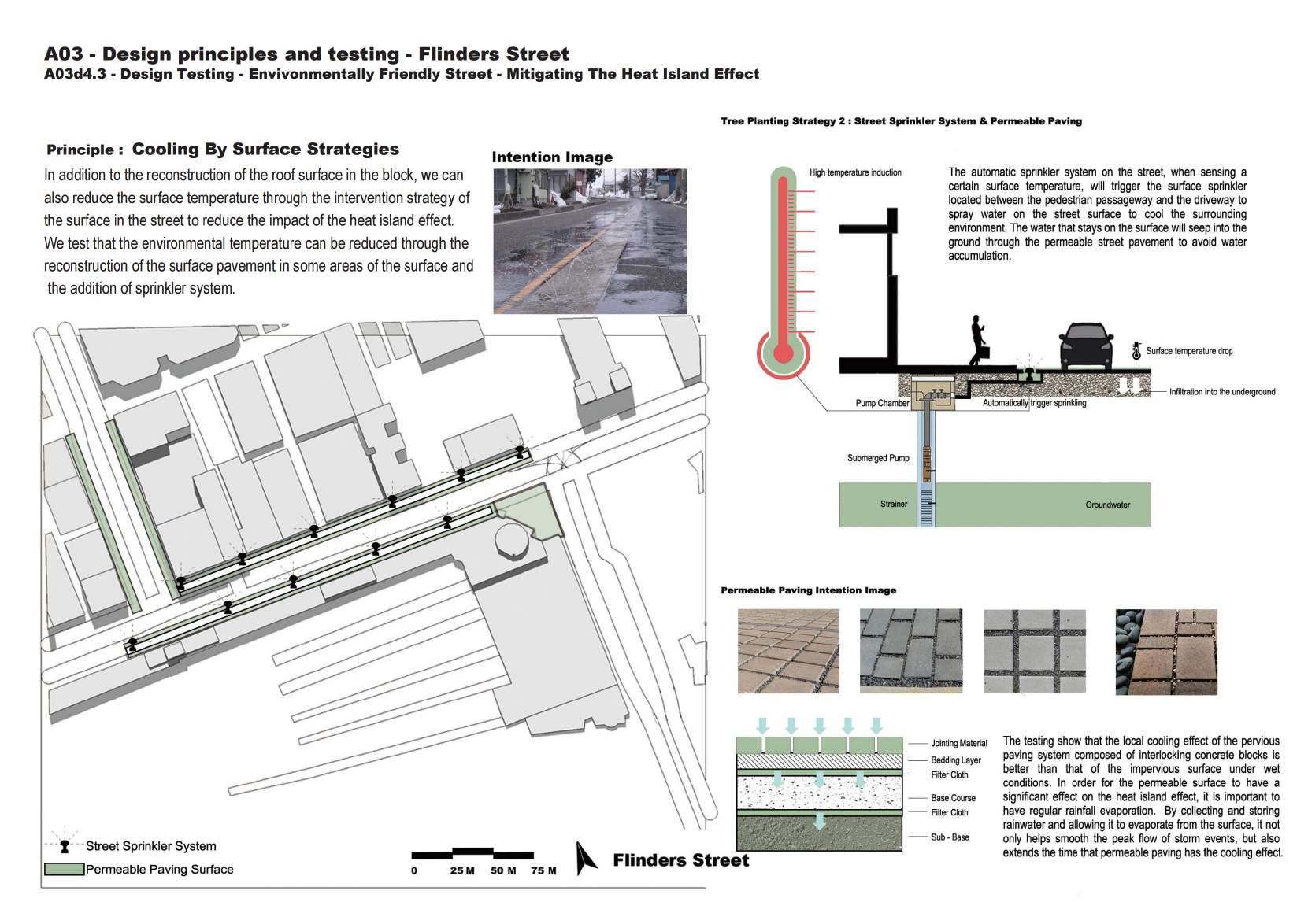

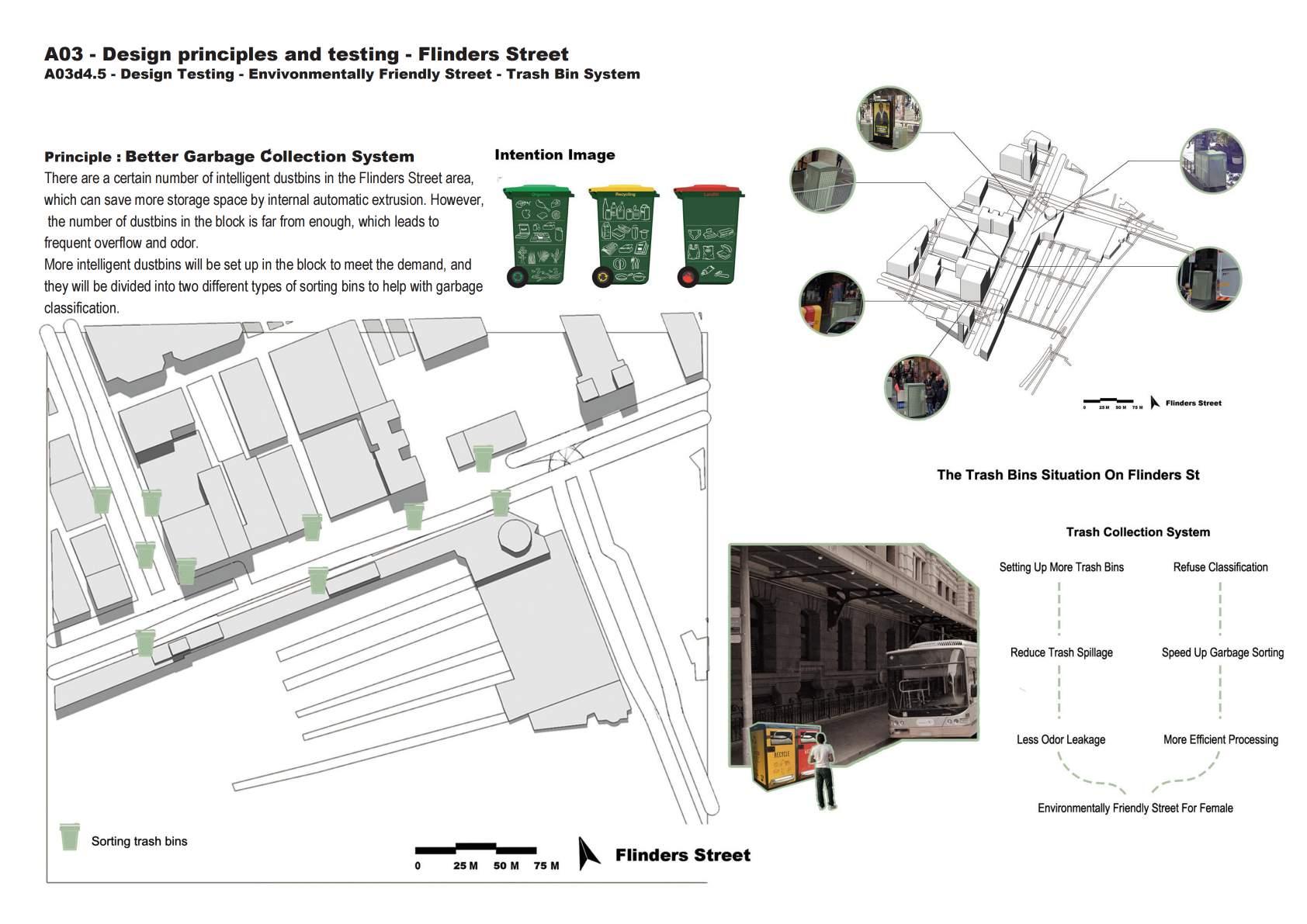
A03 - Design principles and testing - Flinders Street
A03e.1 Future Operation
Work Flow The future maintenance and operation of the site is a determining factor in whether the proposed design strategies can be implemented to Flinders St. Through monitoring of work flow of the site in the later stages, the government can quickly obtain feedback and information from the site so as to assist in the application of new design strategies.
A03e.1.1 - Future Operation - Future Monitoring And Maintenance
Future Monitoring And Maintenance
In terms of site operation, this is a strategy for future site operation after the development of Flinders St.
1. The future maintaining approach to the site is based on workflow design, including site feedback, data collection, site redesign, and re-construction.
2. It is important to establish a site feedback mechanism for Flinders St, to enable the government to continuously gather the voices of the people, in order to restore and improve Flinders St in the future.
Work Flow
Site Feedback
Site Monitoring Voice Collection
The future maintenance and operation methods of the site determines whether the site improving design strategies of the previous part can be implemented to Flinders st or not. Through a series of monitoring work flow of the site in the later stage, the government can quickly obtain feedback information from residents on Flinders st, so as to help Flinders st smoothly apply the new design strategy.
Data Collection

Site Visit
Face - Face Consultation
Redesign Redesign & Publicity
Construction
Based On Construction Strategy

Infomation Collection Equipment
A03 - Design principles and testing - Flinders Street
A03f.1 Master Plan
Detailed Plans Based on the previous testings of design principles, all the details are presented on the detailed plans, which will help to show the comprehensive relationships between the design ideas.
A03f.1.1 - Master Plan - Detailed Plans
Detailed Plans
We select the two most representative spatial nodes on Flinders St, enlarge them, and recombine all the design information into Detailed Plans. Different colors represent different principles. Four major design directions make up the new Flinders St.


A03 - Design principles and testing - Flinders Street
A03g.1 Reference & Appendix
1. Reference list 2. Details of Community Consultation
A03f.1 - Reference
Simone Fox, Koob. 2017. "Melbourne CBD could be free of cars ‘by 2030’" The Australian Business Review, accessed May 19, 2021. https://www. theaustralian.com.au/news/melbourne-cbd-could-be-free-of-cars-by-2030/news-story/b11cd5e14c124d78c8608a60d680c6c0.
THOMAS CONWAY. 2018."Melbourne Plan to Remove Cars from the City". The Urban Developer. accessed May 19, 2021. https://www.theurbandeveloper. com/articles/melbourne-to-reduce-cars-in-cbd
The Department for Transport. UK. 2018. Traffic Signs Manual. Chapter 4 Warning Signs. TSO. ISBN: 9780115536090. https://assets.publishing.service. gov.uk/government/uploads/system/uploads/attachment_data/file/772037/traffic-signs-manual-chapter-4.pdf
Willa, Ng. 2019. "Traffic simulations on our people-first street designs." Sidewalk Talk, accessed May 10, 2021. https://medium.com/sidewalk-talk/httpsmedium-com-sidewalk-talk-street-sim-33da7e1a8ffb
Hemphill, Michael. “A Note on Adults' Color–Emotion Associations.” The Journal of Genetic Psychology 157, no. 3 (1996): 275–80. https://doi.org/10.1080/0 0221325.1996.9914865.
Men, Delai, Yitao Huang, and Xiaoping Hu. "Study of Colors Cognitive Preference in Grotesque Advertising with Influence Factors of Consumers’ Gender, Age and Living Areas." In 2013 International Conference on the Modern Development of Humanities and Social Science, pp. 350-353. Atlantis Press, 2013. https://www.atlantis-press.com/proceedings/mdhss-13/10078
Ciotti, Gregory. "Color psychology: How colors influence the mind." Psychology Today 20 (2014). https://cpb-us-w2.wpmucdn.com/portfolio.newschool.edu/ dist/2/14941/files/2017/06/Color-Psychology_-How-Colors-Influence-the-Mind-_-Psychology-Today-23ggjzj.pdf
Pictures From : 2014 Australia day STREET PARADE fireworks display in Mornington. (n.d.). Retrieved May 11, 2021, from https://www.weekendnotes. com/australia-day-street-parade-fireworks-display-mornington/
How to Apply DDA to STREET Furniture: Seats and tables. (2019, September 24). Retrieved May 14, 2021, from https://streetfurniture.com/how-to-applydda-to-street-furniture-seats-and-tables/
A03f.2 - Appendix
Safety of Women and Minorities - Design Principles Community Consultation
To consult with the users of the site, a site specific survey was designed. This addressed the risks identified through site analysis as well as posing open ended queries about individual’s personal experiences, feelings of safety, specific risk factors and times of day.
In order to reach the widest audience, the survey was completed online. This is done via a QR code which has been distributed around the site in the form of posters and flyers. This approach was deemed favourable to gather the voices of women and others who use the site in a way that is comfortable for people and unimposing. It was felt that to be considerate of women and minorities feelings of safety in public, as well as their time, this approach would be the most appropriate as opposed to conducting face to face interviews.
Men were free to complete the survey too, as we were interested in a wide range of data from which we can draw comparisons and/or similarities.
The survey was designed to be as accessable as possible, using inclusive language and framing. Overall the community consultation has shown that the women and minorities who took part do not find this to be a safe area. The few male responders expressed stronger feelings of saftey that all other responders. Many women had had specific incidences of harrassment or being followed within this site. It is apparent that there are many risk factors in the physical and spatial qualities of the area.
Patterns in the survey data highlight 4 key issues based on responders concerns about the site. These issues will now inform our design testing. These are:
poor lighting alleyways
lack of security presence & general crowds underground train station
A03f.2 - Appendix
How do you identify?
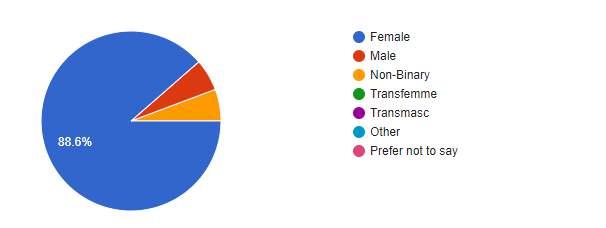

What is your age?


How do you identify? How often are you in this area?




Are you ever in this area at night?


If alone at night, would you actively avoid this area?


A03f.2 - Appendix
Would/do you go down the alleyways in this space alone in the daytime?



Would/do you go down the alleyways in this space alone in the nighttime?
Would/do you go into the underground train station alone in the nighttime? On a scale of 1-10 (1 being least safe and 10 being most safe) how safe do you feel in this area in daylight hours? (In general)
On the same scale, how safe do/would you feel being in this area after dark?



A03f.2 - Appendix
Please specify some reasons for your feelings of safety/unsafety in this space:
"at night there are a lot of drunk people"
"Due to the sexual and verbal abuse that happens to women when they are alone"
"As a woman, being alone at night in public space is always uncomfortable. However, the many alleyways and corners feel unsafe"
"at night there are lots of drunk people around and dark alley ways"
"I don’t feel safe at night in laneways as I am a female"
"Cautious worry I’ll get harassed or bashed if it’s very late at night."
"Police patrol"
"lack of exit points (in alley ways). dark lighting."
"Safety due to business and proximity to police station and unsafety due to generally the city and dark places at night"
"I’m weary of any public space in night time especially when alone and underground / confined space like an alley"
"Irregular security presence at night when less commuters/staff around"
"i never feel safe in public spaces"
"Men make me feel unsafe"
"If no other people visible down a lane way I will avoid it, avoid trains at night but will come to flinders street station to get a taxi."
"There is a lot of junkies in the city, they make it feel unsafe because they are unpredictable."
"Presence of strip bars, seedy people around Elizabeth and Flinders corner - has been like that the last 20 years in have worked an office building in the area" "Minimal police/pso presence, dimly lit"
"the people around, lack of lighting and footpaths"
"Sometimes aggressive behaviour of people who are outside the train station"
"As a highly frequented area I feel that it is relatively safe compared to other areas of the CBD most of the time. However, I was advised by staff in the TAFE building I study at to avoid some of the local alley ways due to previous incidents where students' safety wer threatened."
"Unstable people."
"I feel save always if there is police"
"news reports of incidents"
"Mostly just uncertainty, there's no guarantee the person around the corner isn't mentally ill, or generally aggressive, she or he could lash out, it's near lots of alcohol places (no that the places are the issue, it's the person) it's so crowded, just statistically speaking there's so many people that not all of them can have pure intentions alwaysya know"
"Past experiences with unwanted male attention and being accosted by drug effected people."
"There might be drug affected/desperates in this area and I do not want to be confronted with them asking for money. Basically they would not do any harm but you don’t know who you might come across, that’s the problem not or rough sleepers are troublesome but again you don’t know who you might come across."
"Verbally abusive often using racial slurs individuals who are often intoxicated on alchol and or illict substsnces"
"Sexual harassment from men Feeling “out in the open”
A03f.2 - Appendix
Do you have any suggestions for how this area could be safer for women and minorities?
More police patrols, cameras and better lighting
More lighting maybe camera surveillance installations maybe a closed in area for woman to sit in that is protected. However it wouldn’t stop anyone entering.
More light and more PSO's around
A large, well-paid on-location authoritative body (ideally an NGO) primarily or exclusively consisting of women and minorities who wear mandatory body cameras, have been trained in conflict resolution and social work, and are provided excellent mental health care.
Better lighting and encourage more activity in laneways
A employee of the council. Ie :public safety person, like the elder days.
Good staffing levels maintained
More lighting at night, change how minorities are treated overall
Better lighting at night. Particularly around the thoroughfares towards Flinders st station.
Greater police presence
Having specific areas designated to safety, day and night. Maybe with police n such around.
Escape routes although not sure that would work in this space
More security personnel presence
More lights
More emergency buttons like those in the station
Better lighting, security presence More lights and maybe open shops
Always thought that women only carriages like in Japan are great idea and could be implanted here - or like safe spaces on platforms / designated areas in the train area. Not sure about the rest of the space
Make some stalls slightly larger so people who are travelling with luggage/ children can use the space more easily or have more than one disabled facility that is regularly cleaned.
Designing a well lit area especially for taxi/Uber to collect passengers off the train that is integrated into the stations.
Just more physical presence of people who can protect, physical presence make people more safe
phone booths used only for emergency calls in secluded areas
trained security personnel who are aware of the vulnerability of minorities. although it is a cultural issue
Better tenants in the area!
Lighting, cctv. I think businesses create a feeling of safety as create foot traffic stay home
better lighting
More railway staff over all of the areas not just at myki hub , safer stairs, walkways are uneven
Well lit, CCTV
more exit points and sight lines. welcome spaces that attract people (busy the space! eg plants, seating etc) more inviting light
A03f.2 - Appendix
Are there any specific areas of this space that you feel particularly unsafe in?
No all of them
Dark unlit areas I suppose. Maybe the Elizabeth block where there are a lot of down and outer who hang out there.
underground train station. dark streets
Quiet and dark areas with little amounts of people.
Underground train station
Flinders Street Steps
Laneways with no activity
Yes, middle of the road, or where there is pavement/ door ways that has sharpe edges because when I’ve been drinking or have a big bag it’s dangerous.
Some of the alleyways branching off Flinders Lane.
Areas with less foot traffic
Near the construction areas where there is no visibility
Dark areas with no one around.
Alleyways
When in the toilets, I often have a suitcase and small children. There is no space for us all in a toilet, especially if the disabled toilets are dirty, which they often are. I do not feel safe enough to leave the children outside the stall or my belongings outside the stall.
Having to get a taxi (Southern Cross) in a darker area out on the street. Idk, but main big streets are normally alroght Right outside the station
where there are no street lights
when i am alone in a street, train station etc. and there are only men around
On Elizabeth St near corner of Flinders
I probably wouldn't head down the dead end alleys but if I did would do so quickly
alleyways, outside the pub on the corner
Degraves entrance
The ones that stink of urine
Toilets
Areas of reduced lighting
Areas with fewer people
Alley ways, underground, outside of pubs, anywhere at night where there are drunk people.
everywhere
Probably just on the edges of alleyways. / or at night on main streets when most street shops are closed.
Going to the park
Elizabeth St. near the last tram stop.
A03f.2 - Appendix
Are there any specific areas of this space that you feel particularly unsafe in? (cont.)

In our analysis of site, it is apparent that area contains multiple businesses which serve alcohol into the evening. This can be considered a risk factor for women and minorities using or passing through the site, where they may be victim to alcohol related assault and harassment. 70,000 Australians are victims of alcohol fuelled violence each year (Laslett et. All 2010).
1 The site also contains multiple alleyways and laneways, many of which are dead-ends, have blind corners and are poorly lit. These are a spatial element of the site which we have considered as a major threat to the safety of women and minorities. Many of these alleys contain large skip bins and other hospitality related items which form further obstacles and blind spots. In the infamous and tragic case of 2012, Brunswick woman Jill Meagher was sexually attacked and murdered in an alleyway off Sydney Road.
Alleyways provide cover for potential attacks to occur. They are visually isolated from busier main streets, generally poorly lit and seldom otherwise occupied.
According to the 52 survey results, these are the precise areas that the majority of female and minority responders highlighted as most dangerous. The majority of responders mentioned 'dark alleyways' as the places in this site that they felt most unsafe. The underground train station area was also mentioned frequently as an unsafe area, as well as any other dark and isolated areas. Most responders said they would activley avoid these spaces if alone after dark.
10
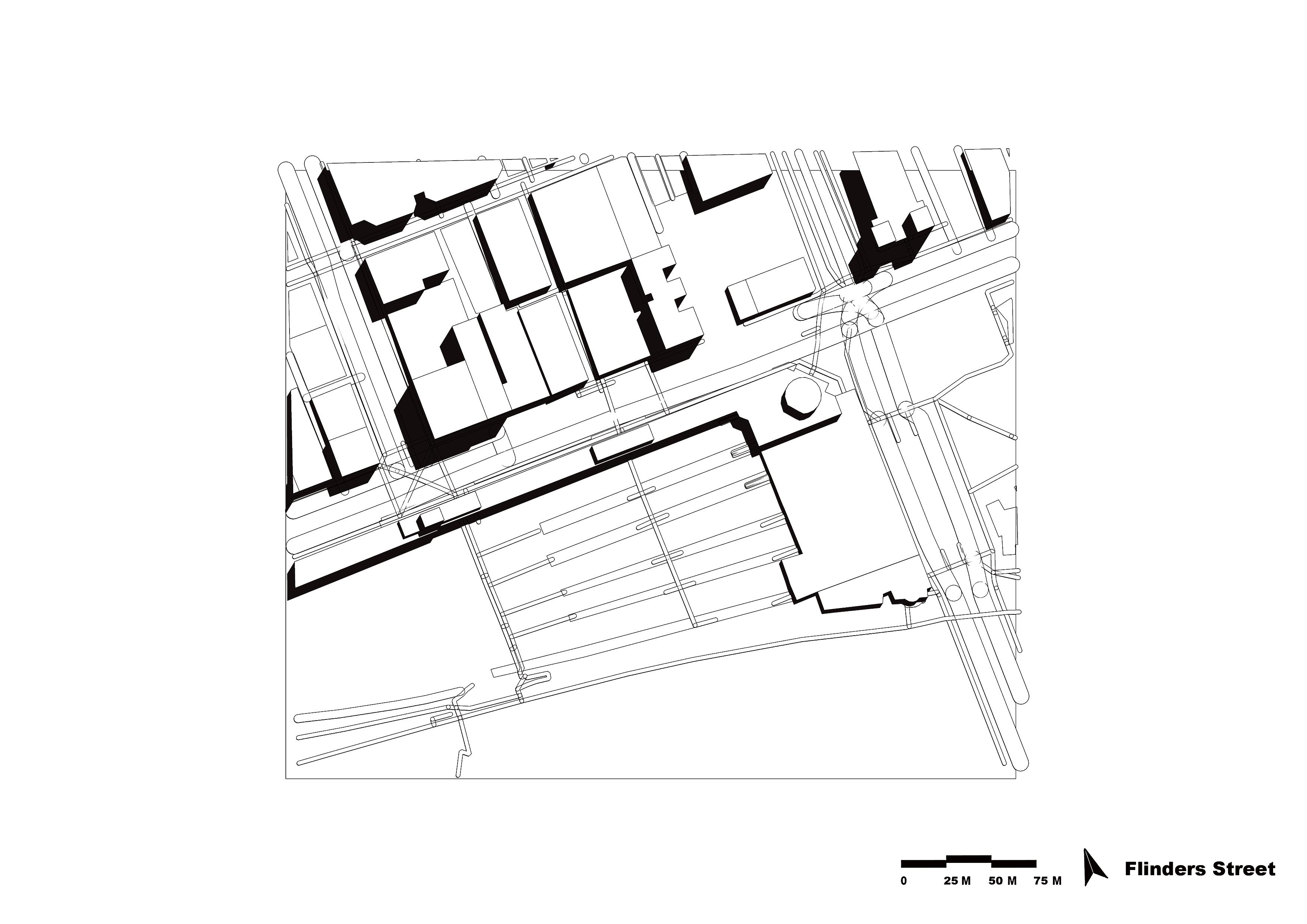
4
1 2 2
10 2
2
4
Points of danger according to community consultation
2 2
2
2

